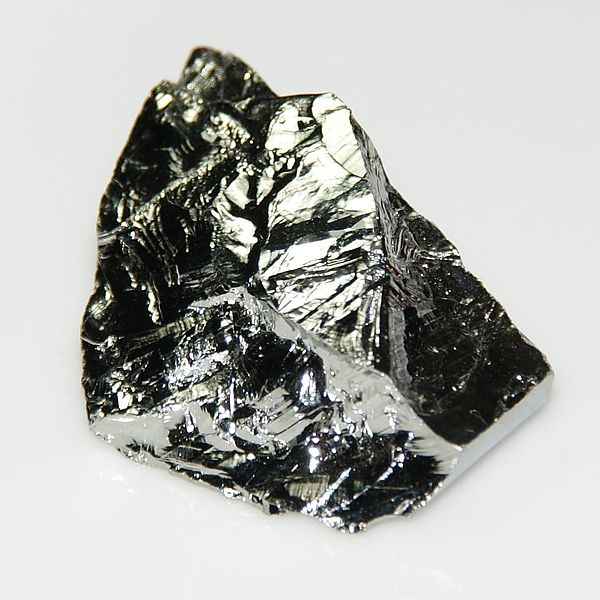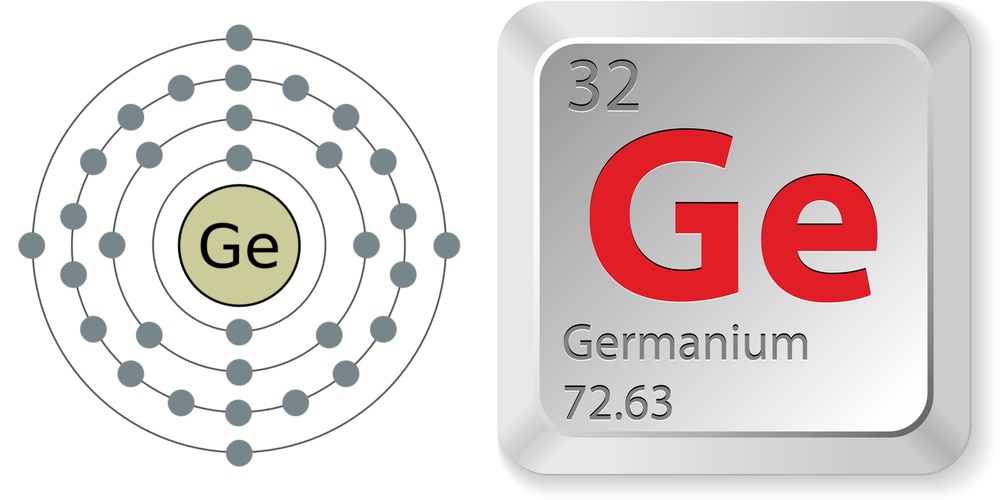Facts About Germanium

Shiny and silvery, yet very brittle, germanium is an important component in semiconductors and fiber optics. Some people think germanium supplements have health benefits, but research has not supported those claims.
Just the facts
- Atomic number (number of protons in the nucleus): 32
- Atomic symbol (on the periodic table of elements): Ge
- Atomic weight (average mass of the atom): 72.630
- Density: 3.077 ounces per cubic inch (5.323 grams per cubic cm)
- Phase at room temperature: solid
- Melting point: 1,720.9 degrees Fahrenheit (938.3 degrees Celsius)
- Boiling point: 5,131 F (2,833 C)
- Number of natural isotopes (atoms of the same element with a different number of neutrons): 5. There are also 19 artificial isotopes created in a lab.
- Most common isotopes: Ge-74 (36.28 percent of natural abundance), Ge-72 (27.54 percent of natural abundance), Ge-79 (20.84 percent of natural abundance), Ge-73 (7.73 percent of natural abundance), Ge-76 (7.61 percent of natural abundance)
History
The existence of germanium was predicted by Russian chemist Dmitri Mendeleev in 1869, after he developed the periodic table of elements, according to Chemistry Explained. Arranging the elements by atomic weight left some gaps in the table. Mendeleev theorized that there were several elements yet to be discovered, including element No. 32. In 1885, Clemens Winkler, a German chemist, discovered what was then referred to as "eka-silicon" in an ore known as argyrodite. The ore contained silver, sulfur, iron oxide, and zinc with about 7 percent of the unknown metal.
According to Chemistry Explained, Mendeleev had predicted that element 32 would have a density of 5.5 grams per cubic centimeter (5.5 times the density of water) and atomic weight of 70 (a little less than four times the atomic weight of water): very close to the actual density (5.323 grams per cubic centimeter) and atomic weight (72.630) of germanium. The accuracy of Mendeleev's prediction increased chemists' confidence in the periodic table.
Who knew?
- Germanium is metalloid, which means it has properties of both metals and nonmetals. Other metalloids on the periodic table are boron, silicon, arsenic, antimony, tellurium, and polonium, according to the Los Alamos National Laboratory.
- Germanium is one of the few elements that expand when it freezes, like water does, according to Chemicool. Others include gallium, silicon, bismuth and antimony.
- The name "germanium" comes from the Latin name for Germany, named for Winkler's home country, according to the Jefferson Lab.
- According to Chemicool, the abundance of germanium in the Earth's crust is about 1.5 parts per million by weight, and the abundance in the solar system is about 200 parts per billion by weight.
- Germanium's value was recognized during World War II, according to Emily Darby, a chemistry student at Harvey Mudd College, when it was used in high-resolution radar receivers. The first germanium transistor was invented shortly afterward.
- According to the U.S. Geological Survey, approximate percentages of the uses of germanium are: 30 percent for infrared (IR) optics, including detectors; 20 percent fiber optics used in communications; 20 percent polyethylene terephthalate used in a variety of products such as cloth fibers, food containers, and resins; 15 percent for electronics and solar cells for solar panels; and 5 percent for phosphors, metallurgy, and organics including medications.
- Germanium is primarily mined with zinc ore as well as with argyrodite, germanite, and coal according to the Los Alamos National Laboratory. According to Chemistry Explained, germanium is mined in Alaska, Tennessee, China, the United Kingdom, Ukraine, Russia and Belgium.
Health claims
There have been claims that germanium may be beneficial for health, including improving the immune system, oxygen supply in the body, and destroying free radicals. According to Healthline, germanium has also been considered to be beneficial in treating allergies, asthma, arthritis, HIV/AIDS and various forms of cancer.
There is, however, little to no scientific support of these claims, and using germanium supplements or medications can lead to many side effects, including kidney damage, anemia, muscle weakness and lack of coordination, and elevated liver enzymes, according to Healthline.
In experiments, a derivative of germanium called spirogermanium has been shown to inhibit replication in certain cancer cells, but human studies show it has adverse effects and is not suitable as an anticancer treatment, according to the Memorial Sloan Kettering Cancer Center.
Current research
Germanium is commonly used in detectors in a variety of fields, according to a study published in Applied Physics Letters in 2016. The study discusses the high efficiency of germanium photodetectors when used in the visible and near infrared spectra of light. The germanium detectors were compared to conventional silicon based photodetectors and, according to the authors, had better signal to noise ratio and responses near the ends of the spectral range of light able to be observed with the detectors.
Get the world’s most fascinating discoveries delivered straight to your inbox.
Germanium was tested for use in photodetectors due to its small bandgap, or the easier ability for electrons to jump to a higher energy state, which is common in semiconductor metals. These photoconductors are used in many types of technologies that are used in our everyday lives such as television remote controls, automatically opening doors common at large stores, and fiberoptic communication systems as well as many scientific uses in astronomy, laboratory research, and environmental monitoring according to LaserFocusWorld. With increased efficiency due to the higher absorption of germanium in photodetectors versus traditional materials such as silicon, more and better information can be received in the target wavelength.
Additional resources

Rachel Ross is a science writer and editor focusing on astronomy, Earth science, physical science and math. She holds a Bachelor of Arts in Philosophy from the University of California Davis and a Master's degree in astronomy from James Cook University. She also has a certificate in science writing from Stanford University. Prior to becoming a science writer, Rachel worked at the Las Cumbres Observatory in California, where she specialized in education and outreach, supplemented with science research and telescope operations. While studying for her undergraduate degree, Rachel also taught an introduction to astronomy lab and worked with a research astronomer.



